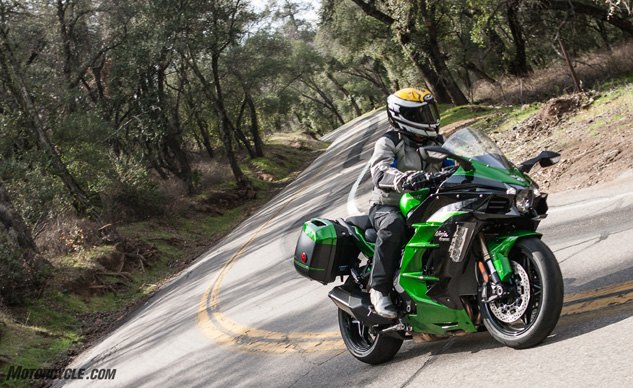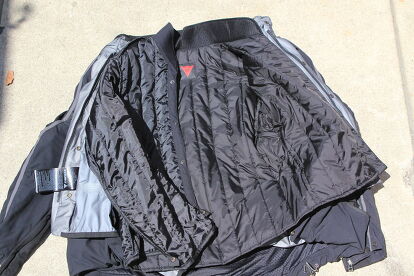Advantages of Motorcycle Touring Gear

One jacket to rule them all...
What is motorcycle touring gear? What defines the category? In a word, versatility. Touring gear is built to shield the rider through the vast array of potential weather a rider might find themselves venturing through during a long ride. There are plenty of different applications and philosophies of what makes for the best touring gear, but when boiled down, it all comes to the versatileness of the product.
Removable liners
One way in which gear manufacturers approach weatherproofing is by offering removable liners in both jackets and pants. These liners may include waterproof inner layers or quilted layers for additional warmth. Motorcycle Touring Gear, or what some refer to as 4-season riding gear, will often have a combination of both a quilted liner and a waterproof liner of some sort.
Waterproof liners often come in two types, the manufacturer’s own proprietary waterproof membrane, or Gore-Tex, which has become the gold standard of waterproof breathability not only in motorcycling, but also in extreme outdoor gear in general. Typically, Gore-Tex equipped offerings will fetch a premium price due to the use of the product, but, as of time of publishing this article, Gore-Tex offers a lifetime warranty on the waterproofness of its products which certainly helps to justify its higher price point.
Quilted liners are a bit more universal in their construction with the variances coming mostly in the way of a vest-type liner which only covers the torso, or full jacket-type liners which fit all the way down into the sleeves.
Most motorcycle touring gear will allow you to use the liners either separately or in conjunction with one another allowing you lighter waterproofness or giving you the option to fully bundle up with the quilted liner attached as well. Some jackets on the market, such as my Dainese D-Explorer, which I have mentioned a few times in previous touring articles, go the extra distance and include substantial venting on the outer shell, giving users the opportunity to really open up the jacket for airflow in hotter conditions.
Built-in weatherproofing
More recently there has been a trend from some of the big names in moto-gear to buck the liners in the conquest of simplicity and less bulk. We’ve seen this from companies like Alpinestars and Dainese when perusing new model lineups and the trend has seemingly caught on. Other companies, like KLIM, have taken the outer-shell-type approach for quite some time allowing users to choose their own mid and base layers while providing a durable weatherproof shell.
My only qualm with this approach to touring is that it generally limits the usefulness and versatility. Take the Alpinestars Hyper Drystar jacket for example; the jacket includes a sewn-in waterproof liner as well as a quilted liner for warmth. Here in southern California, the jacket just isn’t that practical for most of the year because even with the quilted liner out and the total of four vents open, the jacket flows very little air to the rider. If you have to wear a backpack, make that no air. Some may prefer this approach, but to me, the option to add and remove liners as necessary with regard to the climate you happen to find yourself in is preferred, particularly on long hauls.
Touring-specific duds like the new KLIM Badlands Pro is geared toward adventure touring but is a great example of a technical shell-type approach which offers a lot of versatility while allowing users to choose their own base and mid-layers for warmth. The Badlands Pro is a juggernaut in the ADV world and offers a super durable shell with 12 vents on the jacket and four vents on the pant. The Badlands Pro also uses Gore-Tex Pro, which is Gore-Tex mated to the outer shell for less bulk and guaranteed waterproofness.
Making do
No, you don’t have to buy expensive motorcycle touring gear in order to be comfortable on a motorcycle tour, but it’s kind of like riding a bike with cruise control, once you’ve experienced the practicality, versatility, and comfortability, it’s hard to want to go back.
Sure you can pack a cheap rain suit into your luggage and a sweater and call it good, but the versatility of one good touring or 4-season jacket could, in theory, replace most of your riding jackets. They might be expensive in some cases, but when you consider the jacket may pull quadruple duty, that cost split four ways can seem entirely worth it.

Ryan’s time in the motorcycle industry has revolved around sales and marketing prior to landing a gig at Motorcycle.com. An avid motorcyclist, interested in all shapes, sizes, and colors of motorized two-wheeled vehicles, Ryan brings a young, passionate enthusiasm to the digital pages of MO.
More by Ryan Adams













































Comments
Join the conversation
You can call me olde-fashioned but I still swear by my twenty year old Dainese leathers with features save two small vents under the armpits which I only notice when it gets cold. I have a modern textile jacket with two zip-in layers but as JWaller pointed out, the layers are underneath the jacket which means your wallet gets soaked since the only pockets are on the inside of the outer layer - sometimes I think this stuff is designed by people who have never actually ridden. A couple of years ago I rented a bike in Frankfurt and rode to Sicily and back, and yes it was a little cold at the summit of Stelvio (in was late September by then) and a little more than a little warm in Sicily but they were almost perfect for almost everything using the correct under-layers for whatever the day brought. A plus is that everything including helmet, boots, thin rain jacket/pants and all my street clothing fit into one standard wheel-along airline bag for the trip over. And all my travelling gear easily fit into two 28 liter bags on the bike. The inner layers of some of the textile stuff would have filled one bag all by themselves as they don’t compress very well. I guess in the final analysis it is whatever works for you.
Full disclosure though I live in Ontario (GWN version, not CA) and in the last six months the temperature range has been -30 to +36 C (roughly 22 below to 97 above). Adjusting for wind chill and humidex (heat index) that would be 40 below to 111, so perhaps I am just used to dealing with extremes, but in any event if I start to get too hot I just think of January.
Two words: "Aerostich Roadcrafter"
We're done.